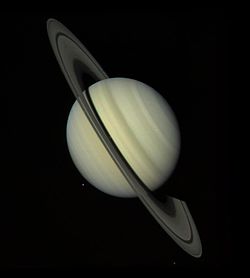Stora vita fläcken


Stora vita fläcken är ett stort anticykloniskt stormsystem i planeten Saturnus atmosfär, som namngivits analogt med den Stora röda fläcken på Jupiter. Stormarna är i perioder tillräckligt stora för att kunna observeras från jorden med teleskop. Stormområdet kan vara åtskilliga tusentals kilometer stort.[1][2]
Fenomenet har en ungefärlig period i 28,5-årscykler, när Saturnus norra hemisfär lutar som mest mot solen. 2010 - 2011 rasade en särskilt stark storm inom den Stora Vita fläcken och andra delar av norra hemisfären, som kommit att kallas "Great Springtime Storm".[3]
Se även
Referenser
- Den här artikeln är helt eller delvis baserad på material från engelskspråkiga Wikipedia, Great White Spot, 3 maj 2020.
Noter
- ^ ”Cassini Helps Solve Saturn’s Mysterious Great White Spots” (på engelska). Sci-News.com. http://www.sci-news.com/space/science-cassini-saturns-great-white-spots-02696.html. Läst 3 september 2020.
- ^ ”NASA: Rare, enormous gas storm detected on Saturn” (på engelska). CNN.com. http://www.cnn.com/2012/10/25/world/saturn-gas-storm/. Läst 3 september 2020.
- ^ Adam Mann (25 december 2010). ”Saturn Storm Creates Largest and Hottest Vortex Ever Seen in Solar System” (på engelska). https://www.wired.com/2012/10/saturn-largest-hottest-vortex/. Läst 3 september 2020.
Externa länkar
- The Great White Spot at ESA/Hubble (engelska)
- Christopher Go's Saturn Website Pictures of Saturn's Northern Electrostatic Disturbance (2011) (engelska)
| ||||||||||||||||||||||||||||
Media som används på denna webbplats
Saturn's Great White Spot storm of 2010-2011, pictured on December 24, 2010 by the Cassini spacecraft. NASA image from https://saturn.jpl.nasa.gov/resources/5331/ . The image may be compared to a photo taken two months later, in February, 2011, in which the spot and its "tail" overlap.
The huge storm (great white spot) churning through the atmosphere in Saturn's northern hemisphere overtakes itself as it encircles the planet in this true-color view from NASA’s Cassini spacecraft. Image credit: NASA/JPL-Caltech/SSI
NASA's Voyager 1 took this photograph of Saturn on Oct. 18, 1980, 34 million kilometers (21.1 million miles) from the planet. The photograph was taken on the last day that Saturn and its rings could be captured within a single narrow-angle camera frame as the spacecraft closed in on the planet for its nearest approach on Nov. 12. Dione, one of Saturn's inner satellites, appears as three color spots just below the planet's south pole. An abundance of previously unseen detail is apparent in the rings. For example, a gap in the dark, innermost ring, called the C-ring or crepe ring, is clearly shown. Material is seen within the relatively wide Cassini Division, separating the middle, B-ring from the outermost ring, the A-ring. The Encke Division is shown near the outer edge of the A-ring. The detail in the rings' shadows cast on the planet is of particular interest: the broad, dark band near the equator is the shadow of the B-ring; the thinner, brighter line is just to the south of the shadow of the less dense A-ring.



